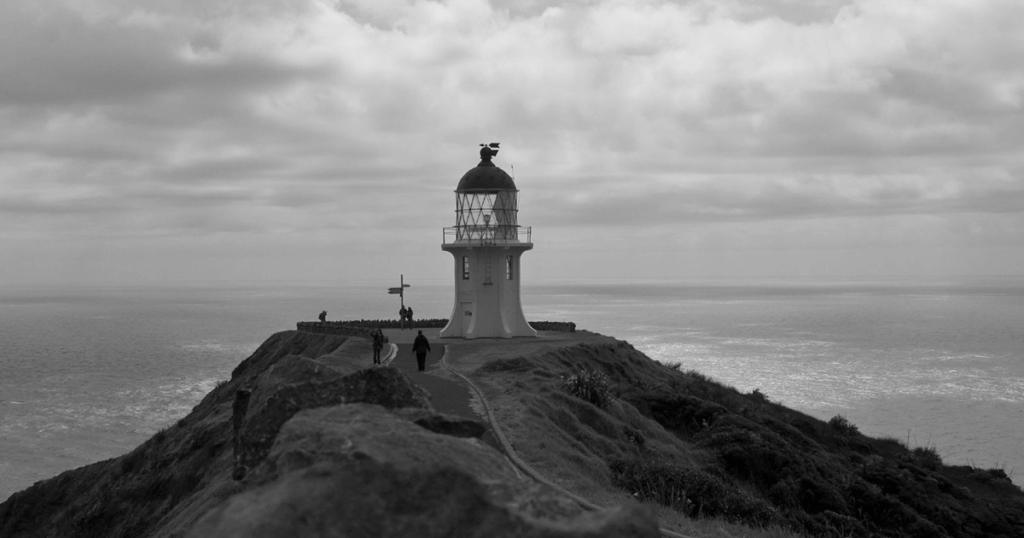The View From the End of the World
Wildfires, volcanoes, and the story of a mythical tree

Cape Reinga is as good a place as any to contemplate the end of the world. Here, on the steep, stark, and windswept headlands at the tip of New Zealand’s North Island, the native Māori claim that the dead depart this earth. The souls of the departed descend the roots of the ancient pōhutukawa tree into the sea below, where they continue their journey into the afterlife. Reinga even comes from the Māori phrase meaning “the leaping place of spirits.”
Still alive, I am among a score or so of visitors milling around the lonely lighthouse, built in 1941, that now marks the spot. Perched on cliffs almost 1,000 feet high, the lighthouse overlooks the confused swells where the Pacific Ocean and Tasman Sea meet.
My guidebook claims that the legendary pōhutukawa tree still stands. Also known as the New Zealand Christmas tree or the “iron tree,” this coastal evergreen produces a brilliant display of red, orange, yellow, or white flowers. The Māori call it the “chiefly tree” and admire it not only for its colorful beauty but also for its hardy strength—it grows and thrive in even the most infertile places, such as the precarious cliffs of Cape Reinga.
But I can’t seem to find the Cape’s venerated pōhutukawa. Why not? Because of my age-diminished powers of observation? My insufficient spirituality? If the tree has indeed disappeared, what is to be blamed? Could possums be the culprits?
The common brushtail possum, an invasive species brought to New Zealand by European settlers in the 1850s, strips pōhutukawa trees of their leaves. From their peak in the 1980s, when the population grew to an estimated 60 to 70 million, the number of possums has been halved thanks to redemptive control measures. But with roughly 30 million remaining, the possum population is still almost 10 times as large as New Zealand’s human population. Leading the possum reduction efforts is a charitable conservation trust, its mission focusing on enabling pōhutukawa to flourish again in their natural habitat as icons in the hearts and minds of all New Zealanders.
When I finally spot what I conclude must be the Cape’s pōhutukawa, many yards from the lighthouse, it hardly looks like a tree at all, or at least not my idea of a tree. It resembles a totem, with trunk and limbs virtually bare. But its wood essence remains alive, though this singular tree apparently, and inexplicably, no longer flowers.
Only 400 miles southeast from Cape Reinga is the North Island’s Bay of Plenty, where I could have been one of the 47 unaware and unlucky visitors on Whakaari/White Island when its volcano erupted, killing 18 people. The remaining 28 were injured, many with horrific burns that covered, in some cases, up to 80 percent of their bodies. It must have been hell on earth, though when Captain James Cook spotted the island as he sailed offshore in 1769, it must have appeared benign—after all, he’s the one who named the island “white.”
Meanwhile, the trees and brush in Australia, on the other side of the Tasman Sea, have burned and burned. It’s the driest and second-hottest spring in Australian history. According to news reports, the flames and noxious fumes have killed at least 27 humans and innumerable animals (as many as 500 million, according to some estimates). For weeks, the fires have been sending wave after wave of flames toward the Australian coast. More than 15 million acres have been consumed so far, and over 1,000 houses destroyed. Survivors have sought the only refuge available—on the seashore.
What to blame? Climate change, is to blame, but like possums, it is not the first cause. Something changed the climate. We of the species who are that “something” can enjoy the sunset here on Cape Reinga, especially beautiful because of the haze from the Australian bushfires over the Tasman Sea. Not unlike the brilliantly colorful display of the pōhutukawa when it flowers. Must the end of the world be so beautiful?

